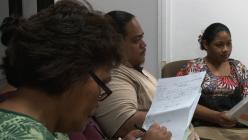Education Facility Inventory and Assessment
- Research Report
Tuesday, February 28, 2012
Department of the Army
The Insular A, B, C’s - Phase II initiative announced by U.S. Department of the Interior, Assistant Secretary for Insular Areas, Anthony Babauta on March 17, 2011, represents a partnership between the governments of Guam, the Commonwealth of Northern Marianas, American Samoa, the U.S. Virgin Islands and the Office of Insular Affairs (OIA), to conduct a baseline inventory and deferred maintenance assessment of 125 public elementary, middle and high schools comprising of approximately 1,600 buildings.
Key Points
- OIA has requested the assistance of the U.S. Army Corps of Engineers, Honolulu District and its consultant Helber Hastert & Fee to conduct the Insular A,B,C’s work. The project was divided into a two phased approach, initiated in August 2010.
- The Phase I Insular A, B, C’s Report was completed in February 2011. The report developed a framework and assessment process for Phase II, relevant to the needs of each territory based on an inventory of facilities and stakeholder input on processes and needs.
- Phase II of the Insular A, B, C's initiative will produce valuable insights for leadership decision making, including the overall physical condition of all school facilities; an accounting of deferred maintenance and replacement values to assist in capital investment decisions; and, identifying trends in maintenance practices and requirements to pinpoint opportunities for efficiencies. Information collected under this initiative will be stored in a centralized information system, allowing each territory to access its own school system data and take advantage of built-in cost modeling, location/GIS mapping, project planning and work order management tools. By conducting the initiative as a regional effort, insular governments will be able to address many of their school systems' needs for maintenance planning, maintenance tracking, and capital planning in a systematic and cost effective manner.
- Additional environmental parameters will be captured for each school to assist managers in prioritizing repair and maintenance investments. These parameters include school grounds conditions (pavement condition, fencing, drainage issues, etc.), natural hazards (flood plain, landslide risk, tsunami inundation, etc.), and emergency response (e.g., is the facility identified as an emergency evacuation center?). Other context parameters such as student enrollment, student/teacher ratios, student/classroom ratios, etc., could also be collected and maintained to inform the evaluation and prioritization process.
Document(s):
| Attachment | Size |
|---|---|
| 1.26 MB |
Associated Link(s):

